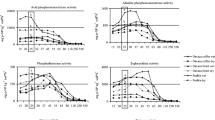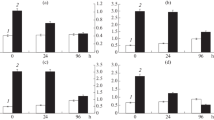Abstract
The course of the biological oxidation of ethylene by soil was dependent on the type of soil used as well as on other factors. As evidenced from an increase in oxidation rate, the ethylene-consuming microorganisms in soil could grow at the expense of ethylene, even when the gas was present at concentrations of 50 ppm or less. Five strains of bacteria strongly resembling each other were isolated from different soils. These pleomorphic, gram-positive, acid-fast, obligate aerobic, ethylene-oxidizing bacteria grew also on saturated alkanes and on ordinary carbon sources. An apparent Km for ethylene of approximately 40 ppm was estimated for whole-cell suspensions of strain E20 by following the disappearance of the gas from the atmosphere.
Similar content being viewed by others
References
Abeles, F. B. 1973. Ethylene in plant biology. — New York and London, Academic Press.
Abeles, F. B., Craker, L. E., Forrence, L. E. and Leather, G. R. 1971. Fate of air pollutants: removal of ethylene, sulfur dioxide, and nitrogen dioxide by soil. — Science 173: 914–916.
Birch-Hirschfeld, L. 1932. Die Umsetzung von Acetylen durch Mycobacterium lacticola. —Zentralbl. Bakteriol. II. Abt. 86: 113–129.
de Bont, J. A. M. 1975. Oxidation of ethylene by bacteria. — Ann. Appl. Biol. 81: 119–121.
de Bont, J. A. M. and Mulder, E. G. 1974. Nitrogen fixation and co-oxidation of ethylene by a methane-utilizing bacterium. — J. Gen. Microbiol. 83: 113–121.
Considine, P. J. and Patching, J. W. 1975. Ethylene production by micro-organisms grown on phenolic acids. — Ann. Appl. Biol. 81: 115–119.
Davies, S. L. and Whittenbury, R. 1970. Fine structure of methane and other hydrocarbon-utilizing bacteria. — J. Gen. Microbiol. 61: 227–232.
Davis, J. B., Chase, H. H. and Raymond, R. L. 1956. Mycobacterium paraffinicum n.sp., a bacterium isolated from soil. — Appl. Microbiol. 4: 310–315.
Guérin, H. 1952. Traité de manipulation et d'analyse des gaz. — Masson (ed.) Paris.
Ilag, L. and Curtis, R. W. 1968. Production of ethylene by fungi. — Science 159: 1357–1358.
Lynch, J. M. 1975. Ethylene in soil. — Nature 256: 576–577.
Lynch, J. M. and Harper, S. H. T. 1974. Formation of ethylene by a soil fungus. — J. Gen. Microbiol. 80: 187–195.
Smith, A. M. and Cook, R. J. 1974. Implications of ethylene production by bacteria for biological balance of soil. — Nature 252: 703–705.
Smith, K. A., Bremner, J. M. and Tabatabai, M. A. 1973. Sorption of gaseous atmospheric pollutants by soils. — Soil Sci. 116: 313–319.
Smith, K. A. and Scott Russell, R. 1969. Occurrence of ethylene, and its significance, in anaerobic soil. — Nature 222: 769–771.
Smith, K. A. and Restall, S. W. F. 1971. The occurrence of ethylene in anaerobic soil. — J. Soil Sci. 22: 430–443.
Tausz, J. und Donath, P. 1930. Über die Oxydation des Wasserstoffs und der Kohlenwasserstoffe mittels Bakterien. — Z. Physiol. Chem. 190: 141–168.
Yoshida, T. and Suzuki, M. 1975. Formation and degradation of ethylene in submerged rice soils. — Soil Sci. Plant Nutr. 21: 129–135.
Author information
Authors and Affiliations
Rights and permissions
About this article
Cite this article
de Bont, J.A.M. Oxidation of ethylene by soil bacteria. Antonie van Leeuwenhoek 42, 59–71 (1976). https://doi.org/10.1007/BF00399449
Received:
Issue Date:
DOI: https://doi.org/10.1007/BF00399449




